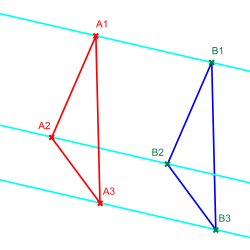Moufang plain
Moufang planes are projective planes in which Desargues' little projective theorem is general. They are named after the German mathematician Ruth Moufang who studied these planes in the 1930s. She was able to show that every Moufang plane is isomorphic to a projective plane over an alternative body . Since a finite alternative body is already a body (see below), the following applies: All finite Moufang planes are Pappus planes . (Note: In a Desargue projective plane, Desargues' great theorem applies . Such a plane can be coordinated over an oblique body and every oblique body is an alternative body, but not the other way around.)
Moufang planes form class VII in the classification of projective planes according to Hanfried Lenz .
If it is an alternative body, a projective plane can be made by using the one -dimensional subspaces generated by an element as points and the two-dimensional subspaces as straight lines , as in a projective space above a body . One then speaks of the projective plane and notes it as . These projective coordinate planes are always Moufang planes. Exactly when the multiplication in the alternative field fulfills the associative law, a skewed field and the plane is a desargue projective plane. Note, however, that with an alternative body that no is skew field, none of the formal displayable coordinate spaces for a projective geometry forms, to compare axiom of Veblen-Young !
Each Moufang plane is isomorphic to a projective coordinate plane over an alternative body , which is uniquely determined by the plane except for isomorphism.
In a theorem of Artin and Zorn that every finite alternative body is a body , it follows that every finite Moufang plane is actually a projective plane over a finite body .
Equivalent descriptions for the term “Moufang level”: A projective level is a Moufang level if and only if
- every affine plane created from it by slitting (affine restriction with regard to a straight line as a distance line) is an affine translation plane ,
- all ternary bodies that can be assigned to the plane as a coordinate range by choosing a projective coordinate system , i.e. by choosing a complete quadrilateral as the point base, are isomorphic,
- one of the coordinate ternary bodies is an alternative body,
- for each straight line of the plane the group of collineations , which fix the straight line point by point , operates transitively on the set of points that do not lie on the straight line ,
- the group of collineations operates transitively on the set of complete quadrilaterals (understood as an ordered set of the four corners).
In the case of a Moufang plane, the affine translation planes mentioned are all isomorphic to one another (as incidence structures ), their coordinate ternary bodies are always quasi-bodies and even alternative bodies that are also isomorphic to one another.
The real octonions are an example of an alternative field that is not a skew, the projective plane the most important example of a non-desargue Moufang plane.
literature
- Marshall Hall : The theory of groups . 2nd Edition. Chelsea Pub. Co., Bronx, NY 1976, ISBN 0-8284-0288-4 .
- Hanfried Lenz : Small Desarguessian sentence and duality in projective levels . In: Annual report of the German Mathematicians Association . tape 57 . Teubner, 1955, p. 20–31 ( Permalink to the digitized full text [accessed December 25, 2011]).
- Ruth Moufang: The introduction of the ideal elements into plane geometry with the help of the theorem of the complete four-sided . In: Mathematical Annals . Volume 105, No. 1 . Hamburg 1931, p. 759-778 , doi : 10.1007 / BF01455845 .
- Ruth Moufang: Alternative body and the sentence of the complete four-page . In: Dep. Math. Sem . tape 8 . Hamburg 1933.
- Ruth Moufang: On the structure of alternative bodies . In: Mathematical Annals . Volume 110, Number 1, 1935, pp. 416-430 . , Digitized
- Günter Pickert : Projective levels . 2nd Edition. Springer, Berlin / Heidelberg / New York 1975, ISBN 3-540-07280-2 .
- Charles Weibel : Survey of Non-Desarguesian Planes . In: Notices of the American Mathematical Society . Volume 54, November 2007, pp. 1294–1303 ( full text (PDF; 719 kB) [accessed December 25, 2011]).
- Max August Zorn : Theory of Alternative Rings . In: Dep. Math. Sem . Volume 8, Number 1. Hamburg 1930, p. 123-147 , doi : 10.1007 / BF02940993 .
Individual evidence
- ↑ Moufang (1933)
- ↑ Alternative fields by Hauke Klein HTML (Eng.)
- ↑ Lenz (1954) and Lenz types by Hauke Klein: HTML (Engl.)
- ↑ To be more precise, a subspace is to be understood here as a sub-module of the - left module .
- ↑ Weibel (2007) p. 1296.
- ↑ Hall (1959) 20.5.3
- ↑ Wrath (1930)
















